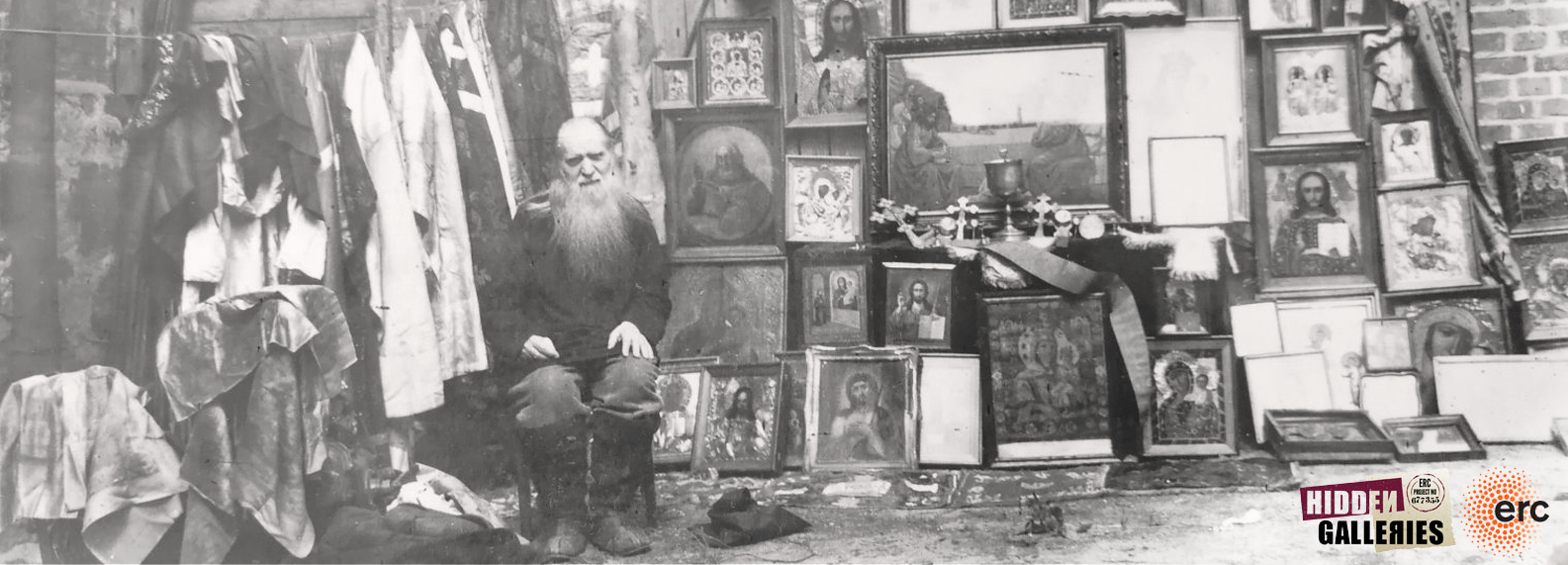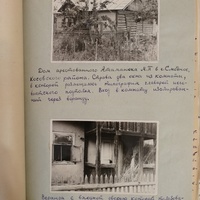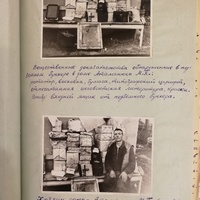Jehovah's Witnesses bunker printing press Ukraine
Item
Title
Jehovah's Witnesses bunker printing press Ukraine
Підпільна друкарня Свідків Єгови, Україна
Подпольная типография Свидетелей Иеговы, Украина
Description
These images were included in a 14-volume criminal file against seven Jehovah’s Witnesses (JW) leaders from western Ukraine (former Drohobych and Stanislav region), 1955-1956. The photographs were produced during a police raid of an underground bunker printing press operated by the Witnesses in a rural location. The photographs were used as incriminating evidence of their clandestine illegal activities.
The first image shows a rural private house in Smodne village under which the bunker was constructed. The place was also used as a safe house where several members of the JW organisation were hiding to avoid arrest. The top photograph from the second image shows a bunker air-way masked with sheaves. The third image shows the evidence found as a result of the police search: confiscated printing equipment (rotator, wax stencil, paper, typeface, and ink), samizdat religious materials, as well as an entrance box from the bunker. The bottom photograph on the third image pictures an arrested believer (and the owner of the house) sitting with the confiscated items.
The bunker printing press was discovered by the police in 1955 as a result of a major secret operation against the JW leadership in Ukraine. Among the arrested persons was Bogdan Terletsky, the leader of the Jehovah’s Witnesses in the Soviet Union from 1953-1955, who had been on a secret police wanted list since 1950. Under intense pressure and after numerous interrogations, Terletsky’s spirit was broken and he agreed to cooperate with the secret police. Later, during the 1960s, he would give evidence in trials against other Jehovah’s Witnesses.
The Soviet authorities considered the Witnesses an anti-Soviet organisation and denied it legal recognition. The Soviet secret police conducted mass arrests of the Witnesses, carried out two major deportations of the Witnesses and their families from the western Ukrainian borderland and Moldova (in 1949 and 1951), and ran numerous secret operations to disclose their complex underground networks. Despite state repression, the Witnesses in the Soviet Union proved remarkably resilience, with the number of members steadily growing throughout the entire Soviet period (see Baran 2014). The repression they endured made the Jehovah’s Witnesses in the Soviet Union an insular organisation, with internal hierarchy and leadership, a coded reporting system and finances, smuggling operations, and clandestine communication channels. They also ran a complex underground network of printing presses that were of particular targets to the secret police.
The images come from the State Archive Branch of the Security Services of Ukraine in Kyiv. The file reference is: fond 5, sprava 42795, tom 13. The file consists of fourteen volumes and contains interrogation records of arrestees and witnesses, reports of the police raid, decisions of a commission of experts regarding the anti-Soviet message of confiscated religious literature, etc. The whole volume (No. 14) consists of confiscated Jehovah’s Witnesses material: coded financial and missionary reports, internal instructions, a list of names of arrested Witnesses with addresses of detention places, personal correspondence and photographs.
For further readings see:
Baran, Emily. 2014. Dissent on the Margins: How Soviet Jehovah's Witnesses Defied Communism and Lived to Preach About It. Oxford University Press.
Berezhko, K.A. 2012. Istoriia Svidkiv Egovy v Ukraini: u 5 tomakh. Feodosiia: Art-Life.
Ivanenko, S.I. 2002. Svideteli Iegovy – traditsionnaia dlia Rossii religioznaia organizatsiia. Moscow: Art-Busines-Center.
For related entries see:
The first image shows a rural private house in Smodne village under which the bunker was constructed. The place was also used as a safe house where several members of the JW organisation were hiding to avoid arrest. The top photograph from the second image shows a bunker air-way masked with sheaves. The third image shows the evidence found as a result of the police search: confiscated printing equipment (rotator, wax stencil, paper, typeface, and ink), samizdat religious materials, as well as an entrance box from the bunker. The bottom photograph on the third image pictures an arrested believer (and the owner of the house) sitting with the confiscated items.
The bunker printing press was discovered by the police in 1955 as a result of a major secret operation against the JW leadership in Ukraine. Among the arrested persons was Bogdan Terletsky, the leader of the Jehovah’s Witnesses in the Soviet Union from 1953-1955, who had been on a secret police wanted list since 1950. Under intense pressure and after numerous interrogations, Terletsky’s spirit was broken and he agreed to cooperate with the secret police. Later, during the 1960s, he would give evidence in trials against other Jehovah’s Witnesses.
The Soviet authorities considered the Witnesses an anti-Soviet organisation and denied it legal recognition. The Soviet secret police conducted mass arrests of the Witnesses, carried out two major deportations of the Witnesses and their families from the western Ukrainian borderland and Moldova (in 1949 and 1951), and ran numerous secret operations to disclose their complex underground networks. Despite state repression, the Witnesses in the Soviet Union proved remarkably resilience, with the number of members steadily growing throughout the entire Soviet period (see Baran 2014). The repression they endured made the Jehovah’s Witnesses in the Soviet Union an insular organisation, with internal hierarchy and leadership, a coded reporting system and finances, smuggling operations, and clandestine communication channels. They also ran a complex underground network of printing presses that were of particular targets to the secret police.
The images come from the State Archive Branch of the Security Services of Ukraine in Kyiv. The file reference is: fond 5, sprava 42795, tom 13. The file consists of fourteen volumes and contains interrogation records of arrestees and witnesses, reports of the police raid, decisions of a commission of experts regarding the anti-Soviet message of confiscated religious literature, etc. The whole volume (No. 14) consists of confiscated Jehovah’s Witnesses material: coded financial and missionary reports, internal instructions, a list of names of arrested Witnesses with addresses of detention places, personal correspondence and photographs.
For further readings see:
Baran, Emily. 2014. Dissent on the Margins: How Soviet Jehovah's Witnesses Defied Communism and Lived to Preach About It. Oxford University Press.
Berezhko, K.A. 2012. Istoriia Svidkiv Egovy v Ukraini: u 5 tomakh. Feodosiia: Art-Life.
Ivanenko, S.I. 2002. Svideteli Iegovy – traditsionnaia dlia Rossii religioznaia organizatsiia. Moscow: Art-Busines-Center.
For related entries see:
Дані фото знаходяться у 14-томній кримінальній справі проти лідерів свідків Єгови (СЄ) у Західній Україні (колишні Дрогобицька і Станіславська області), 1955-1956рр. Фотографії були зроблені під час поліцейського рейду на підпільну друкарню свідків у сільській місцевості. Світлини були використані як доказ вини у таємній незаконній діяльності.
На першому фото – приватний будинок у селі Смодне, під яким і був побудований бункер. Місце також використовувалося для переховування декількох членів СЄ від арешту. Верхня фотографія показує бункер з повітря, замаскований снопами. На третьому фото – речі, знайдені внаслідок обшуку: конфісковане друкарське зналаддя (ротатор, восковий трафарет, папір, гарнітура і чорнила), релігійний самвидав, а також вхідна коробка бункера. Нижня фотографія у третьому файлі показує заарештованого віруючого (і власника будинка) , що сидить поруч з конфіскованими речами.
Бункер з друкарнею був знайдений поліцією у 1955 р. в результаті спецоперації служби безпеки проти лідерів СЄ в Україні. Серед заарештованих був Богдан Терлецький, лідер свідків Єгови у Радянському Союзі у 1953-1955рр., який був у розшуку з 1950 р. Під тиском і після численних допитів, Терлецький зламався і погодився співпрацювати з органами. Пізніше, у 1960х, він давав показання у суді проти свідків Єгови.
Радянська влада вважала свідків антирадянською організацією і відмовила їм у законному визнанні. Радянська таємна поліція проводила масові арешти свідків. Крім того, були організовані дві депортації свідків разом із сім’ями з прикордонних регіонів західної України і Молдови (у 1949 р. і 1951р.), а також, численні таємні операції, направлені на розкриття їх підпільних мереж. Незважаючи на репресії з боку держави, свідки показали визначну стійкість , постійно збільшуючи кількість прихильників протягом всього радянського періоду (см. Baran, 2014). Через постійні репресії свідки Єгови стали ізольованою організацією, із внутрішньою ієрархією, закодованою системою звітності і повідомлень, контрабандними операціями і таємними каналами комунікації. Вони також налаштували мережу друкарень, що були особливо цікавими таємній поліції.
Фотографії зберігаються у Галузевому державному архівi Служби безпеки України, фонд 5, справа 42795, том 13. Справа складається з 14 томів і містить протоколи допитів заарештованих і свідків, звіти щодо поліцейських рейдів, висновки комісії щодо антирадянського посилу конфіскованої релігійної літератури. Повний том (№ 14) складається з конфіскованих у свідків Єгови матеріалів: закодованих фінансових і місіонерських звітів, внутрішні інструкції, список імен заарештованих свідків з адресами місць затримання, персональні листи і фотографії.
Subject
Communism and Christianity--Europe, Eastern
Communism and religion
Communism--Europe, Eastern--History--20th century
Secret police (secret service)
Surveillance
Material culture--Religious aspects
Religion and politics--Europe
Christian sects--Soviet Union
Communism and culture--Soviet Union
Communism--Soviet Union--History--Sources
Confiscations
Evidence fabrication
Evidence photographs
Millenialism
Nationalism and communism
Soviet Union. Ministerstvo gosudarstvennoĭ bezopasnosti
Trials (Political crimes and offenses)--Soviet Union
Underground literature--Soviet Union
Underground press publications
Creator
Tatiana Vagramenko
Source
Галузевий державний архів Служби безпеки України
ГДА СБУ ф. 5, спр. 42795, том 13
ГДА СБУ ф. 5, спр. 42795, том 13
Publisher
This project has received funding from the European Research Council (ERC) under the European Union’s Horizon 2020 research and innovation programme No . 677355
The research for this entry was funded by Irish Research Council, GOIPD/2017/764
The research for this entry was funded by Irish Research Council, GOIPD/2017/764
Date
1955-1956
Rights
Copyright for these images belongs to the State Archive Branch of the Security Services of Ukraine
Format
Image/ jpg
Image
Image
Language
RU
UKR
RO
Type
Image
Identifier
SBU Archive, f. 5, spr. 42795, t. 13
Coverage
Ukraine
Soviet Union
20th Century
Soviet Union
20th Century
Bibliographic Citation
Tatiana Vagramenko, "Jehovah's Witnesses bunker printing press Ukraine",
Date Created
2018



